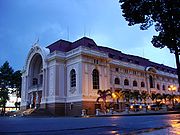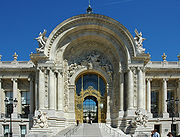
Municipal Theatre, Ho Chi Minh City
Encyclopedia

Ho Chi Minh City
Ho Chi Minh City , formerly named Saigon is the largest city in Vietnam...
, Vietnam
Vietnam
Vietnam – sometimes spelled Viet Nam , officially the Socialist Republic of Vietnam – is the easternmost country on the Indochina Peninsula in Southeast Asia. It is bordered by China to the north, Laos to the northwest, Cambodia to the southwest, and the South China Sea –...
, is an example of French Colonial
French Colonial
French Colonial a style of architecture used by the French during colonization. Many French colonies, especially those in South-East Asia, have previously been reluctant to promote their colonial architecture as an asset for tourism, however in recent times, the new-generation of local authorities...
architecture in Vietnam.
Built in 1897 by French architect Ferret Eugene, the 800 seat building was used as the home of the Lower House assembly of South Vietnam
South Vietnam
South Vietnam was a state which governed southern Vietnam until 1975. It received international recognition in 1950 as the "State of Vietnam" and later as the "Republic of Vietnam" . Its capital was Saigon...
after 1956. It was not until 1975 that it was again used as a theatre, and restored in 1995.
Architecture
Saigon Opera House is a smaller counterpart of the Hanoi Opera HouseHanoi Opera House
The Hanoi Opera House is an opera house in central Hanoi, Vietnam. It was erected by the French colonial administration between 1901 and 1911. It was modeled on the Palais Garnier, the older of Paris's two opera houses, and is considered to be one of the architectural landmarks of Hanoi.The Hanoi...
(built from 1901 to 1911, and shaped like the Opéra Garnier in Paris
Paris
Paris is the capital and largest city in France, situated on the river Seine, in northern France, at the heart of the Île-de-France region...
). The Saigon Opera House owes its specific characteristics to the work of architect Félix Olivier, while construction was under supervision of architects Ernest Guichard and Eugène Ferret in 1900.

French Third Republic
The French Third Republic was the republican government of France from 1870, when the Second French Empire collapsed due to the French defeat in the Franco-Prussian War, to 1940, when France was overrun by Nazi Germany during World War II, resulting in the German and Italian occupations of France...
with the façade shaped like the Petit Palais
Petit Palais
The Petit Palais is a museum in Paris, France. Built for the Universal Exhibition in 1900 to Charles Girault's designs, it now houses the City of Paris Museum of Fine Arts ....
which was built in the same year in France
France
The French Republic , The French Republic , The French Republic , (commonly known as France , is a unitary semi-presidential republic in Western Europe with several overseas territories and islands located on other continents and in the Indian, Pacific, and Atlantic oceans. Metropolitan France...
. The house had a main seating floor plus two levels of seating above, and was capable of accommodating 1,800 people. The design of all the inscriptions, décor, and furnishings were drawn by a French artist and sent from France.
However, the décor of the façade faced some criticisms. In accordance with Gothic style, the house facade was decorated with inscription and reliefs (like City Hall), but it was criticized as being too complicated. In 1943, some of the complicated decoration was removed. On the occasion of 300th anniversary of Saigon in 1998, the city government had some façade decor restored.
History
After the complete invasion of CochinchinaCochinchina
Cochinchina is a region encompassing the southern third of Vietnam whose principal city is Saigon. It was a French colony from 1862 to 1954. The later state of South Vietnam was created in 1954 by combining Cochinchina with southern Annam. In Vietnamese, the region is called Nam Bộ...
, in 1863 the French colonists invited a theatre company to Saigon to perform for the French legion in the villa of the French admiral at the Clock Square (Place de l'Horloge) (today, this is the corner of Nguyen Du and Dong Khoi streets). After a short time, a temporary theatre was built at the site of what is now the Caravelle Hotel
Caravelle Hotel
The Caravelle Hotel is located in Ho Chi Minh City, Vietnam. The hotel was opened to the public on Christmas Eve 1959, when the city was known as Saigon...
. In 1898, the construction of the new theatre commenced on the site of the old one, and it was completed by 1 January 1900.
Between World War I
World War I
World War I , which was predominantly called the World War or the Great War from its occurrence until 1939, and the First World War or World War I thereafter, was a major war centred in Europe that began on 28 July 1914 and lasted until 11 November 1918...
and World War II
World War II
World War II, or the Second World War , was a global conflict lasting from 1939 to 1945, involving most of the world's nations—including all of the great powers—eventually forming two opposing military alliances: the Allies and the Axis...
, all costs of mobilization and demobilization as well as other costs for the theatre companies from France to Saigon were paid by the municipal government. Despite the fact that the theatre was planned as an entertainment venue for the growing middle class, its audience declined as more and more night clubs and dance halls boomed in the city. During this period, performances were presented only occasionally, some being concerts and others cai luong
Cai luong
Tuồng cải lương or cải lương in short, which can be roughly translated as "reformed theater" or "renovated theater" in English, is a form of modern folk opera in Vietnam...
programs.
Following from the criticisms of the theatre’s façade and the high costs of organizing performances, the municipal government intended to turn the theatre into a concert hall (Salle de Concert), but this was never carried out. Instead, the theatre façade's decorations, engravings and statues were removed in 1943 to make the theatre look more youthful. In 1944, the theatre was damaged by the Allied
Allies of World War II
The Allies of World War II were the countries that opposed the Axis powers during the Second World War . Former Axis states contributing to the Allied victory are not considered Allied states...
aerial attacks against Japanese Imperial Army and the theatre stopped functioning. As Japan surrendered to the Allied forces, France returned to Cochichina. In 1954, the French army surrendered to Viet Minh
Viet Minh
Việt Minh was a national independence coalition formed at Pac Bo on May 19, 1941. The Việt Minh initially formed to seek independence for Vietnam from the French Empire. When the Japanese occupation began, the Việt Minh opposed Japan with support from the United States and the Republic of China...
during the Battle of Dien Bien Phu
Battle of Dien Bien Phu
The Battle of Dien Bien Phu was the climactic confrontation of the First Indochina War between the French Union's French Far East Expeditionary Corps and Viet Minh communist revolutionaries. The battle occurred between March and May 1954 and culminated in a comprehensive French defeat that...
which led to the Geneva Accords
Geneva Conference (1954)
The Geneva Conference was a conference which took place in Geneva, Switzerland, whose purpose was to attempt to find a way to unify Korea and discuss the possibility of restoring peace in Indochina...
in the same year. The theatre was then used as a temporary shelter for French civilians immigrating from North Vietnam.
In 1955, the theatre was restored for the purpose of becoming the seat of the Lower House of the State of Vietnam
State of Vietnam
The State of Vietnam was a state that claimed authority over all of Vietnam during the First Indochina War, and replaced the Provisional Central Government of Vietnam . The provisional government was a brief transitional administration between colonial Cochinchina and an independent state...
, then the Republic of Vietnam. After the Fall of Saigon
Fall of Saigon
The Fall of Saigon was the capture of Saigon, the capital of South Vietnam, by the People's Army of Vietnam and the National Liberation Front on April 30, 1975...
in 1975, the building was restored to its original function as a theatre. In 1998, on the occasion of 300th anniversary of the founding of Saigon, the municipal government had the theatre façade restored.

